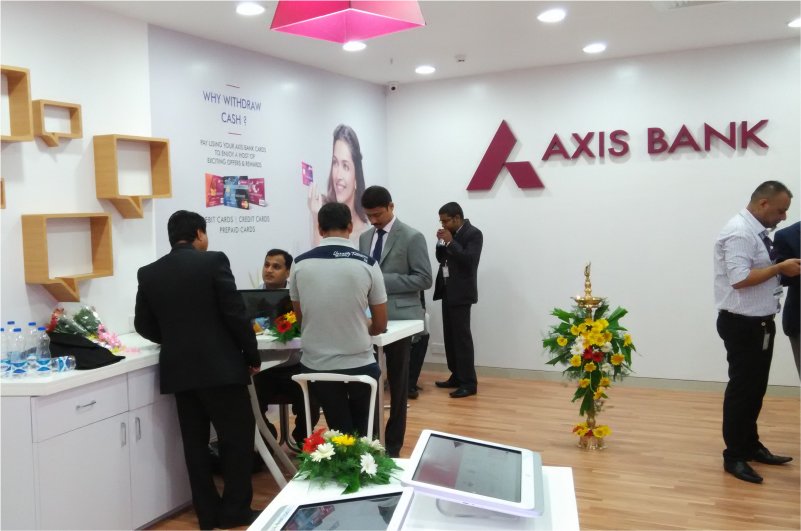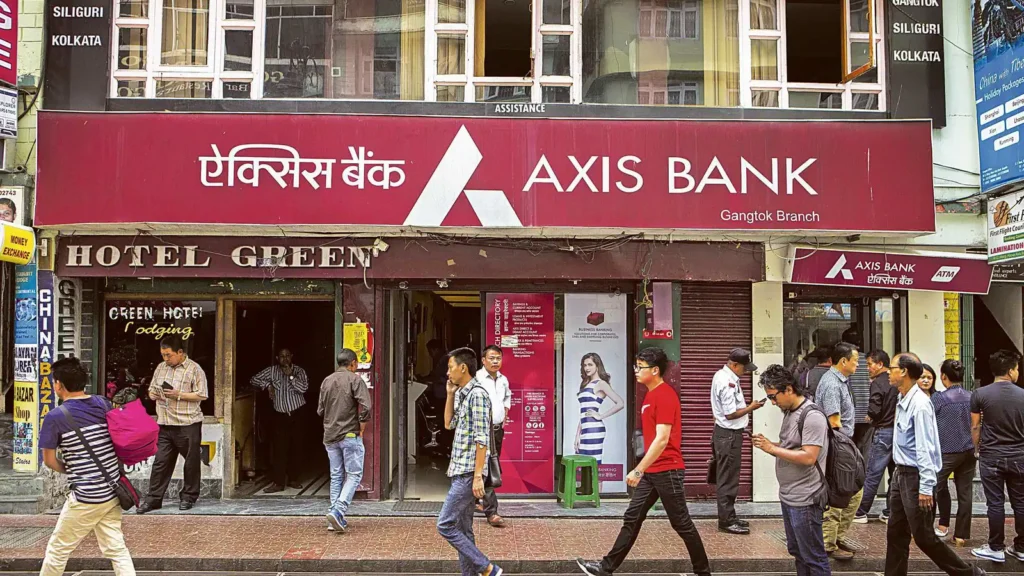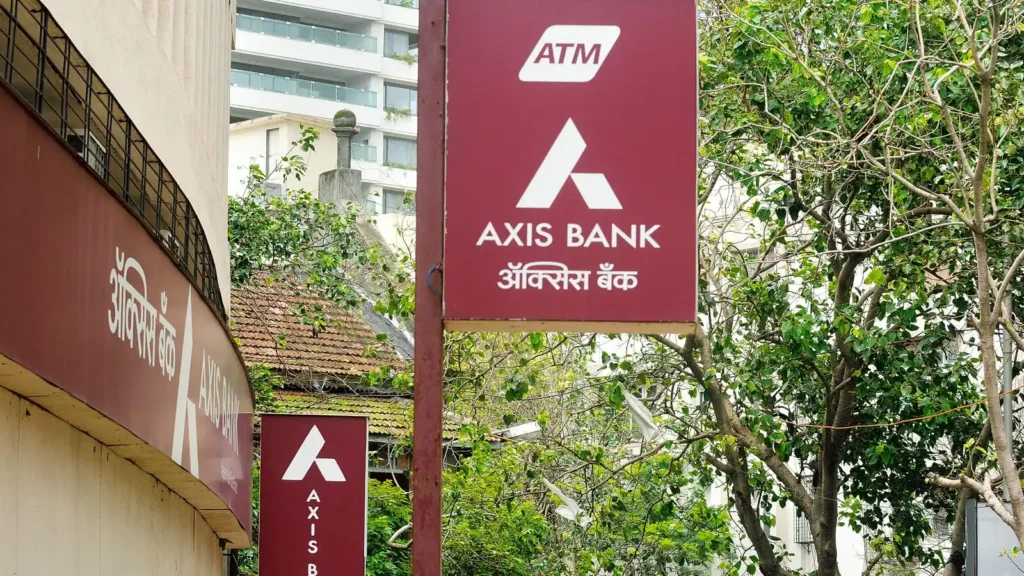Imagine walking into a bank and feeling an immediate sense of trust and reliability. The friendly smiles, the reassuring words, and the seamless banking experience make you feel like your financial journey is in safe hands. That’s the power of Axis Bank, one of India’s leading private sector banks.
For years, Axis Bank has been serving diverse customers with its wide range of financial services. Whether it’s personalized banking solutions or innovative digital offerings, this bank has always strived to meet the unique needs of its customers.
Today, we delve into the SWOT analysis of Axis Bank, examining its strengths, weaknesses, opportunities, and threats. By analyzing these factors, we gain valuable insights into the bank’s current position in the banking sector and its potential for future growth.

Jump Ahead To :
Key Takeaways:
- Axis Bank has established itself as a leader in cloud-based solutions and digital banking capabilities.
- The bank faces challenges in maintaining stable net profits.
- Opportunities lie in expanding the insurance sector and increasing rural penetration.
- Threats come from the rise of fintech companies and reduced customer spending.
- External factors such as political, economic, social, technological, legal, and environmental aspects impact the bank’s operations.
- Some Competitors of Axis Bank include ICICI Bank , HDFC Bank , State Bank Of India (SBI) & Kotak Mahindra Bank
Strengths of Axis Bank
Axis Bank, a prominent player in the Indian banking sector, possesses several key strengths that contribute to its success and competitive advantage in the market.
One of Axis Bank’s notable strengths lies in its early leadership in cloud-based solutions. This technological edge allows the bank to deliver efficient and scalable digital services to its broad customer base, enhancing their banking experience and enabling seamless transactions.
Moreover, Axis Bank exhibits distinctive digital banking capabilities, positioning itself as a frontrunner in the rapidly evolving banking industry. By leveraging advanced technology and innovative solutions, the bank stays ahead of the curve, meeting the changing needs and preferences of its customers.
Additionally, Axis Bank has proven to be a consistent performer in the Asset Management Company (AMC) space. Its Asset Management business has experienced steady growth, accompanied by a strong performance track record. This achievement further reinforces the bank’s reputation as a trusted and reliable financial institution.
Another strength worth noting is Axis Bank’s recognition as one of the leading private sector agricultural lenders in India. By catering to the specific financial needs of the agricultural sector, the bank has successfully established a strong foothold in this niche market, further diversifying its portfolio and contributing to its overall growth.
In conclusion, the strengths of Axis Bank, including its early leadership in cloud-based solutions, distinctive digital banking capabilities, robust performance in the Asset Management business, and prominence in agricultural lending, position the bank for continued growth and success in the dynamic banking landscape.
Weaknesses of Axis Bank
In spite of its notable strengths, Axis Bank does face certain weaknesses that have impacted its financial stability. One of the prominent weaknesses revolves around the bank’s struggle to maintain consistent net profits, resulting in ongoing financial volatility. This particular vulnerability exposes the bank to potential risks, necessitating meticulous management to ensure the long-term stability and profitability of Axis Bank.
“Despite its strengths, Axis Bank has faced challenges in maintaining stable net profits over the years, resulting in financial volatility.”
It is crucial for Axis Bank to address this weakness by implementing effective strategies to enhance its profitability and minimize financial risks. By improving its net profits, the bank can bolster its overall financial health, strengthen investor confidence, and secure its position within the highly competitive banking sector.
To mitigate this weakness, Axis Bank must focus on understanding and rectifying the underlying factors contributing to its financial volatility. This could involve analyzing the bank’s cost structure, operational inefficiencies, and revenue generation methods.
Issues affecting Axis Bank’s net profits:

- Asset Quality: Challenges in managing non-performing assets (NPAs) pose a significant impact on Axis Bank’s net profits.
- Provisions and Contingencies: The bank’s provisions and contingencies may have direct implications for its net profits, emphasizing the need for a robust risk assessment and potential contingency planning.
- Competitive Landscape: Intense competition within the banking industry may impose pressure on Axis Bank’s profitability, requiring the bank to differentiate its products and services to maintain a competitive edge.
Addressing these weaknesses will allow Axis Bank to fortify its financial position, enhance its market standing, and forge a sustainable path towards future growth and profitability.
| Weaknesses of Axis Bank | Impact | Potential Strategies |
|---|---|---|
| Volatility in net profits | Exposes the bank to potential risks | Implement measures to stabilize net profits and minimize financial risks |
| Challenges in managing NPAs | Negatively affects net profits | Focus on improving asset quality and implementing effective NPA management strategies |
| Provisions and contingencies | Directly impacts net profits | Strengthen risk assessment and contingency planning to minimize provisions and contingencies |
| Intense competitive landscape | Puts pressure on profitability | Differentiate products and services to maintain a competitive edge |
Opportunities for Axis Bank
Axis Bank has identified several key opportunities that can further enhance its position in the banking sector.
Integrating Healthcare and Wellness
The bank has the opportunity to incorporate healthcare and wellness into its cards market offering. By providing innovative financial solutions that cater to the healthcare needs of customers, Axis Bank can tap into a growing market segment. This strategic move can not only accelerate the bank’s growth but also attract a larger customer base looking for comprehensive financial products that align with their health and wellness goals.
Rural Penetration Expansion
Axis Bank can leverage its strong presence in urban areas to expand its services and offerings in rural markets. By partnering with Common Service Centres, the bank can provide accessible banking facilities and financial services to the unbanked population in rural regions. This expansion can foster greater financial inclusion and contribute to the economic development of these areas while simultaneously increasing Axis Bank’s market share.
Max Life Insurance Partnership
The rising stake of Axis Bank in Max Life Insurance presents a significant opportunity for the bank to strengthen its foothold in the insurance sector. This partnership allows Axis Bank to offer a wide range of insurance products to its customers, catering to their diverse needs. By providing insurance services alongside banking products, the bank can enhance its value proposition and create deeper relationships with customers who value the convenience of an all-in-one financial provider.
Acquisition of Citibank’s Verticals
The recent acquisition of Citibank’s verticals provides Axis Bank with a direct opportunity to increase its market share. By incorporating Citibank’s retail banking operations, loans, credit cards, and wealth management into its own portfolio, Axis Bank expands its customer base and strengthens its position in the highly competitive banking industry. This acquisition aligns with the bank’s growth, profitability, and sustainability strategy, providing new avenues for revenue generation and business expansion.
By capitalizing on these opportunities, Axis Bank can further solidify its position as a leading player in the banking sector, expand its customer base, and drive sustainable growth in the coming years.
Threats to Axis Bank
Axis Bank, like many other financial institutions, faces several threats that can impact its market position and profitability. These threats include:
- Fintech Disruption: The rise of fintech companies presents a significant threat to Axis Bank. These innovative and agile startups are disrupting the stability of market share in the banking sector. By offering convenient and user-friendly digital banking services, fintech companies attract customers away from traditional banks, including Axis Bank. To stay competitive, Axis Bank must continue to invest in its digital capabilities and offer innovative solutions to meet evolving customer expectations.
- Reduced Customer Spending: Another threat to Axis Bank is the potential decrease in customer spending. Economic instability or changes in consumer behavior can impact the bank’s business from the commercial segment. If businesses and consumers reduce their expenses or delay investments, Axis Bank may experience a decrease in lending and transaction volumes, leading to lower revenues.
- Spillover Effects of IL&FS Crisis: The Infrastructure Leasing & Financial Services (IL&FS) crisis can have indirect consequences on Axis Bank, particularly on its subsidiary, Axis Finance. The IL&FS crisis, which involved significant defaults and financial irregularities, has shaken the confidence of investors and lenders in the non-banking financial company (NBFC) sector. As a result, Axis Finance may face challenges in raising funds and maintaining liquidity, impacting its ability to support Axis Bank’s overall operations.
To mitigate these threats, Axis Bank must remain vigilant and proactive in adapting to the changing landscape of the banking industry. It should focus on strengthening its digital banking offerings, increasing customer engagement, diversifying its revenue streams, and closely monitoring the performance of its subsidiaries.

PESTLE Analysis of Axis Bank
The PESTLE analysis of Axis Bank provides insights into the various factors influencing its business. Understanding these external factors is crucial for the bank to adapt its strategies and stay ahead in the ever-evolving banking industry.
Political Factors
One political factor that may impact Axis Bank is the suggested policy of granting banking licenses to corporates by the Reserve Bank of India (RBI). This could potentially increase competition in the sector, requiring the bank to enhance its offerings and differentiate itself from new entrants.
Economic Factors
Axis Bank may face added costs due to the moratorium interest waiver and changing non-performing asset (NPA) handling, especially with the establishment of a bad bank. These economic factors can impact the bank’s profitability and financial stability.
Social Factors
Consumer preferences for self-service and the increasing adoption of blockchain technology for payments can significantly impact Axis Bank’s operations. The bank needs to align with the changing social trends and offer innovative digital solutions that cater to customers’ evolving needs.
Technological Factors
The use of big data analytics is transforming the way banks assess consumer behavior and make business decisions. Axis Bank must leverage advanced analytics capabilities to gain valuable insights, enhance customer experiences, and drive competitive advantage in the digital era.
Legal Factors
The policy of granting banking licenses to corporates, if implemented, may lead to increased competition in the industry. Axis Bank should closely monitor any legal changes and proactively adapt its strategies to maintain its market position.
Environmental Factors
India’s green banking trend, which emphasizes sustainability and environmental responsibility, can impact consumer behavior and influence their preferences and choices. Axis Bank must align its practices with these environmental factors to remain relevant and meet the expectations of environmentally-conscious customers.

Financial Performance of Axis Bank
Axis Bank’s financial performance in the fiscal year 2023 showcased a significant growth in various key indicators. The bank reported a robust performance in terms of net interest income, non-interest income, and operating profit.
The net interest income of Axis Bank witnessed a remarkable increase of 30%, which reflects the bank’s ability to generate substantial revenue from its core banking activities. This growth can be attributed to the bank’s effective interest rate management and a well-diversified loan portfolio.
The non-interest income of Axis Bank also witnessed a positive trend, contributing to the overall financial performance. This growth in non-interest income highlights the bank’s success in generating revenue from sources other than traditional lending, such as fees and commissions from various banking services.
Additionally, Axis Bank demonstrated strong operational efficiency with an operating revenue growth of 23%. This indicates the bank’s ability to manage its expenses while expanding its business operations.
Despite these positive trends, Axis Bank experienced a decrease in its net profit due to exceptional items associated with the acquisition of Citibank’s India Consumer Business. These exceptional items impacted the bank’s bottom line. However, it is important to note that such one-time events can have a temporary effect on net profit and do not necessarily reflect the bank’s overall financial health.
Furthermore, Axis Bank showcased commendable risk management practices with provisions and contingencies decreasing by 64% compared to the previous year. This decrease indicates the bank’s successful management of potential credit risks and demonstrates its strong asset quality.
Financial Performance Summary:
| Metrics | Fiscal Year 2023 |
|---|---|
| Net Interest Income | Increased by 30% |
| Non-Interest Income | Positive growth |
| Operating Revenue | Grew by 23% |
| Net Profit | Decreased due to exceptional items |
| Provisions and Contingencies | Decreased by 64% |
Acquisition of Citibank India Consumer Business
Axis Bank made a significant move in the Indian banking sector with its acquisition of the consumer businesses of Citibank India. This strategic acquisition includes loans, credit cards, wealth management, and retail banking operations, providing Axis Bank with a gateway to a premium customer segment.
The acquisition of Citibank India Consumer Business aligns perfectly with Axis Bank’s growth, profitability, and sustainability strategy. By expanding its product offering and customer base, Axis Bank aims to strengthen its position in the Indian banking market and enhance its overall competitiveness.
The acquisition involved Axis Bank paying an estimated adjusted purchase price and a further payable statutory amount based on the assets and liabilities acquired from Citibank India. This investment demonstrates the bank’s commitment to expanding its market presence and capturing new opportunities in the consumer banking sector.
Benefits of the Acquisition
- Access to a premium customer segment: The acquisition of Citibank India’s consumer businesses provides Axis Bank with access to a highly desirable customer segment, enabling it to offer a wider range of products and services to its newly acquired customer base.
- Expansion of product portfolio: With the addition of Citibank India’s loans, credit cards, wealth management, and retail banking operations, Axis Bank can diversify its product portfolio and meet the evolving needs and preferences of its customers.
- Increased market share: The acquisition allows Axis Bank to expand its market share and strengthen its position in the highly competitive Indian banking sector, positioning it as a formidable player in the industry.
By acquiring the consumer businesses of Citibank India, Axis Bank has positioned itself for greater growth and success in the Indian banking market. This strategic move not only enhances its product offerings but also allows the bank to tap into a premium customer segment, enabling it to build stronger customer relationships and drive long-term profitability.
| Benefits | Description |
|---|---|
| Access to a premium customer segment | Provides Axis Bank with access to a highly desirable customer segment, enabling it to offer a wider range of products and services. |
| Expansion of product portfolio | Diversifies Axis Bank’s product portfolio and allows it to meet the evolving needs and preferences of its customers. |
| Increased market share | Enables Axis Bank to expand its market share and strengthen its position in the highly competitive Indian banking sector. |
Conclusion
In conclusion, Axis Bank has demonstrated its strengths in digital capabilities and strategic partnerships, positioning itself as a key player in the banking sector. However, the bank also faces challenges in maintaining net profits, which requires careful management and effective strategies.
On the positive side, Axis Bank has identified opportunities to expand its presence in the insurance sector and rural markets, tapping into new customer segments and driving growth. However, the bank must also be vigilant in navigating threats from fintech disruption and reduced customer spending, which can impact its market position.
The PESTLE analysis highlights the external factors that influence Axis Bank’s operations, including political, economic, social, technological, legal, and environmental aspects. Considering these factors and adapting to changes in the industry will be crucial for the bank’s long-term success.
Despite these challenges, Axis Bank’s financial performance remains strong, with notable growth in net interest income, non-interest income, and operating profit. Moreover, the acquisition of Citibank’s India Consumer Business offers new growth opportunities and aligns with the bank’s strategic goals.






